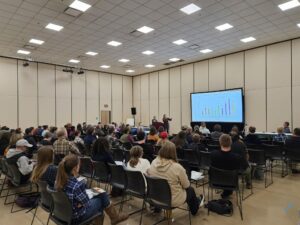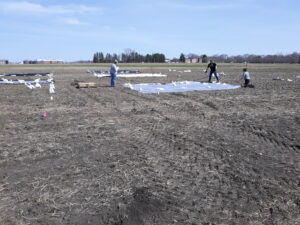Progress report for LNC22-460
Project Information
Using silage tarps as a method of controlling weeds and conditioning soil in small diversified vegetable farms has enthusiastic adherents; the use is spreading in many areas of the U.S. and Canada. However, most of the research and demonstration of tarping has been in higher rainfall regions of the eastern U.S., with one SARE study as far west as Wisconsin.
We used a two-pronged approach of testing tarping at research farms in Iowa and South Dakota, and demonstrated their efficacy on cooperating farms across a range of soils and climate spanning from eastern Iowa to western South Dakota. The effects of short-term tarping treatments on soil health are largely unknown, so we also are assessing effects of tarping durations of 14, 24, or 42 days on soil temperature, moisture, and microbial activity. Because our cooperating farmers had particular interest in controlling early season weeds, we applied tarps in the spring prior to planting onions. We also compared tarping to early-season solarization, using clear plastic, which warms the soil much more efficiently, leading to germination of warm season weeds so that they can be controlled prior to planting the desired crop.
The demonstration farms used management practices appropriate to their farm; thus we gained information on an array of on-farm practices that may impact tarping efficacy. Because the demonstration farms cover a wide variety of soils and span a range of 18 to 36 inches precipitation per year, we expect that there will also be variation in weed species and their response to tarping. Results are being made available to a wide audience through field days, webinars, videos, reports, and presentations at grower meetings.
Neither year found onion yield differences due to tarping treatments. Patterson outyielded Candy onions, mostly due to undersized Candy bulbing. Clear plastic allowed for early weed germination, with subsequent light tillage before planting, similar to a stale seed bed technique. Analysis of weed and soil results are ongoing.
Objectives:
1. Compare efficacy of tarps (occlusion) vs. clear plastic (solarization) vs. no plastic for minimizing early season weed pressure under a range of soils and climates
2. Demonstrate on-farm feasibility of using tarps across a range of soils, climates, and management practices
3. Investigate the effect of occlusion or solarization on soil microbes and soil health
4. Investigate whether early season tarping treatments affect onion yield.
Learning outcomes:
+ Participants will learn how to manage tarps or plastic for maximum efficacy and profitability on their farms
Action outcomes:
+ Tillage and/or herbicide use will be reduced on farms using tarps
+ Using recycled tarps reduces landfill waste
One relatively new method to reduce weed competition is soil tarping. Our farmer advisory group was particularly interested in using tarping to reduce early season weeds. When tarps are applied in early spring and removed before planting, they can reduce weed pressure for early season crops. Two tarping methods are solarization and occultation. Solarization uses clear plastic to harness energy from the sun and warm the soil. The goal behind solarization is to exhaust the weed seed bank before planting to reduce the number of weeds coming up during the growing season. In some cases, it can raise temperatures high enough to kill germinated weed seedlings. Occultation uses an opaque material to stop light from hitting weed seeds and therefore stops germination. It can deprive any existing seedlings or perennial plant parts of light needed for survival. The length of time a tarp is on the ground may also impact weed pressure.
Much of the research and usage of tarping has occurred in more humid areas in the eastern United States (Kennenbrew et al. 2023). The purpose of this tarping project is to study the performance of tarping to reduce weed pressure and increase yield under sunnier, windier conditions. Since onions have a very minimal canopy and therefore do not provide much soil coverage, they have high susceptibility to weed pressure, thus were chosen as a test crop.
Cooperators
- - Technical Advisor
- - Technical Advisor
Research
Tarping will allow germination but not growth of early season weeds. Clear plastic will allow both early germination and growth of early season weeds, reducing the seed bank and thereby reducing early season weed pressure on the onions.
RESEARCH FARMS: Replicated field trials were implemented at the SDSU Specialty Crops Field (SDSU-SCF) in Brookings, SD, and at the Iowa State University Horticulture Research farms to a) assess tarping performance under two distinct environmental and soil conditions, b) insure against climate hazards (such as hail) that could damage a season of field research at a single location, and c) improve access to field research by specialty crop producers within and near the two states.
Treatments were applied Spring 2023 and Spring 2024, for 14, 28 or 42 days:
- Greenhouse plastic / solarization
- Silage tarp - white side up
- Silage tarp - black side up
- Control (no covering)
Each treatment was replicated four times, leading to a total of 48 plots (4 treatments x 4 reps x 3 timings) at each location. Following removal of the tarps, drip irrigation was installed, and a double row of onions transplanted into each plot and grown out for the remainder of the season. Onions were selected because they can be grown as a late season crop, and because they do not form much of a crop canopy and thus are vulnerable to competition from weeds. Temperature and soil moisture of the beds were monitored during the plastic/tarp treatments, and weeds were collected at least three times throughout the season, separated into grasses and broadleaves, and dry weights recorded. Labor needed to control weeds in each plot for two blocks was recorded, and disease/insect damage noted. Onion yields, including number and size, were recorded at the end of the season. All data was analyzed at the end of the each season and presented to the farm advisory committeeas well as multiple producer meetings. Final results will be shared via presentations and/or posters at grower conferences, field days, extension social media, and refereed journal articles.
To assess tarping effects on soil health and function, several soil health indicators were monitored before and after tarping treatments. Potassium-permanganate oxidizable carbon (POX-C), soil protein and soil respiration will be monitored as proxies for soil microbial activity. POX-C is a labile form of C that is considered a ready form of energy for soil microbes. Measuring soil protein in the soil provides an indicator of potentially available N for microbial metabolism. This value also serves as a general measure of overall soil health with higher values indiciative of a healthier soil. Lastly, respiration is a measure of the metabolic activity of the soil microbial pool with higher values corresponding to a larger, more active microbial community. Basic soil chemical composition (P, K, pH, OM) was determined before and after removal of the tarps from each treatment and assessed at depths of 0-6 inches and 6-12 inches.
COOPERATING FARMS: Small-scale vegetable growers from central, and western South Dakota (see below) and Iowa were supplied with clear plastic and silage tarps to treat 20 ft x 20 ft. demonstration plots on their farm. The research team worked with each farmer cooperator to determine the length of time to tarp the soil based on their unique production challenges and planned cash crop. Cooperators reported any pre-existing weeds, soil test results, tarp application and removal dates, and weed pressure, as well as yield (when applicable) for each of the covering treatments. In addition, they kept a photographic record of the tarping treatments.
Growers in the two states and research team members participated in an evaluation meeting after the first season. Results were shared and participants discussed their experiences and made recommendations for modifications for the second season. Results will be available to a wider audience through field days, webinars, social media, videos, reports, and presentations at grower meetings.
Iowa:

- Mean soil temperature for 42-day treatments revealed clear tarp treatments had higher soil temperatures (71.4°F) than black tarp treatments (2°F). Control treatments (58.7°F) had higher soil temperatures than white tarp treatments (53.1°F).
- Black and white tarp treatments had a weed-free planting bed upon tarp removal; clear tarp treatments stimulated weed growth therefore, had to be field cultivated prior to planting the onion crop.
- Clear tarps applied early in the growing season stimulated weed growth underneath the tarp. However, high enough temperatures were not reached to kill the weeds during Iowa’s early growing season.
- 6-Week Clear tarp treatments had significantly higher percent weed cover than all other treatments two weeks after tarp removal. 2-Week Black tarp treatments had significantly lower percent weed cover compared to all other treatments.
South Dakota:
- At tarp removal broadleaf weight in all tarping treatments was less than broadleaf weight of the control treatment (p ≤ 0.001). The control and six-week clear tarp treatment plots had the highest grass weight averages, followed by two-week clear and four-week clear. All black and white tarp treatments showed very low grass weights when compared to the clear and control treatments (p = 0.004). Broadleaf counts were highest in the control treatment followed by the clear tarp treatments (p ≤ 0.001). Grass counts were highest in the two-week clear treatment, closely followed by the six-week clear and the control treatment (p = 0.002).
- During the growing season, there were not many differences in weed pressure among tarp treatments. A few differences were seen in data collected through August 1. The 6-week clear had an average broadleaf count of weeds per acre that was 67% less than the control and 74% less than the 4-week black tarp.
- Tarping treatments had no effect on onion yield.
Farm Collaborators
- Collaborators noted low weed growth under the opaque (black, white) tarps. A mid-summer applicaton led to chlorotic/necrotic creeping jenny under the opaque tarps, and algal growth under the clear. The clear tarp showed higher temperature and soil moisture at 4" soil depth compared to the black tarp or the control.
Early season tarping treatments did not impact subsequent onion yields. Growers were intrigued by results on their farms, and plan to continue experimenting with early- to mid-season use with various crops.
Education
Graduate and undergraduate students learn on the job as they apply tarps, place sensors, set up drip irrigaiton, take weed data, maintain plots, and harvest onions. Graduate students then analyze data and discuss their research results at field tours, short courses, and producer conferences, as well as online research reports and extension articles.



Project Activities
Educational & Outreach Activities
Participation summary:
The two graduate students carrying out this project presented information on our project, and on tarping in general, at a variety of venues, including field days, seminars, a virtual vegetable short course and an in-person short course, and at Marbleseed Organic Conference. At each venue they answered questions and encouraged discussion among the producers. They published articles and research reports on the Extension websites, and developed three videos with over 730 views.
Learning Outcomes
- Early season tarping effects
- Early season solarization effects
Project Outcomes
Use of soil tarp to decrease weed pressure